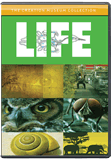The Mystery of Life
One of creation’s wonders is so commonplace that we don’t notice it. Yet it’s more marvelous than all the others . . . life. What mysterious quality makes a creature alive at one moment but is absent the instant the creature dies? What is this mystery of life?
No matter how much scientists learn about the complexities of organisms, they have not touched the more difficult questions—what is life itself, and where did it come from?
Have you ever thought about what life actually is? What mysterious quality makes a creature alive at one moment but is absent the instant the creature dies? A baby’s body, no longer breathing after it has just died, contains the same DNA, the same heart and body, and the same mass as it did only moments earlier. So what is missing?
An entry in Wikipedia admits, “There is no universal definition of life; there are a variety of definitions proposed by different scientists.” The latest Encyclopedia Britannica agrees that there is no “Although the scientists, technicians, and others who participate in studies of life easily distinguish living matter from inert or dead matter, none can give a completely inclusive, concise definition of life itself.” Nevertheless, the encyclopedia’s online version attempts a clunky definition with lots of complex scientific terms:
A biochemical or molecular biological definition sees living organisms as systems that contain reproducible hereditary information coded in nucleic acid molecules and that metabolize by controlling the rate of chemical reactions using proteinaceous catalysts known as enzymes.
Such definitions don’t actually state what life is, merely what we see in living things. For instance, the biologist and philosopher Harold J. Morowitz comments that living things have one thing in common—cells: “The only life we know for certain is cellular.”1
The teaching guidelines for British textbooks suggest that students ages 11 to 14 learn that life is anything that displays seven qualities, summarized in the cute mnemonic MRS. GREN. That is, living objects have Movement, Respiration, Sensitivity, Growth, Reproduction, Excretion, and Nutrition. These properties are typical of cellular life, but they still don’t say what life actually is.
Advanced as computer technology may become, a living thing is still leaps beyond.
To help us understand the problem with defining life, a cell can be compared to a powerful computer—a highly sophisticated system that stores and processes information. There is more to a working computer than its physical parts—it needs a designer, a programmer, and an engineer to build its parts. Then it needs a source of power and an operator to turn it on.
Advanced as computer technology may become, a living thing is still leaps beyond. Despite its complexity, the computer is not alive. Consider a house fly buzzing about an office on a blistering day. If the power shuts down, the computer “dies,” but it can be rebooted after the power is restored. Not so with the fly.
No Definition in Scripture
Plants Are Not Alive?
The Bible assigns “life” to animals, not to plants. Plants are merely described as “green things” (Job 39:8). Most scientists would agree that any life in plants is of a different order than that in animals. If we saw a dead tree in a forest, we wouldn’t be repulsed—we might even sit on the stump! Most of us, however, would not consider sitting on a dead animal. Similarly, we are happy to place dead flowers in a vase, but most homes would not display dead mice.
While the Bible makes a big deal about the wonders of life, it never actually defines it. God introduced this special thing on Day Five of creation: “And God said, Let the waters bring forth abundantly the moving creature that hath life” (Genesis 1:20, KJV).
The Hebrew word used for the quality of having life is nephesh. Leviticus 17:11 shows us that this life is related to having blood: “For the life of the flesh is in the blood, and I have given it to you upon the altar to make atonement for your souls; for it is the blood that makes atonement for the soul.”
The word nephesh is translated in this particular verse as life, but also as soul. Yet, although the life is in the blood, this verse does not tell us what life actually is.
The sort of life described in the Bible is not physical. While life clearly produces physical results that we can observe, that quality called “life” is something intangible.
Life, by God’s Command
No matter how much scientists discover about the physical systems in organisms and their possible origin, they still have no clue about the infinitely more difficult question of where life came from. If you could make a baby from scratch, with all its physical parts in place, you still would not have a living human.
The Bible gives us the answer. Life is a gift from God, a blessing from the Creator Himself. By God’s command, not physical accident, it is granted or removed.
“And [Job] said, Naked I came from my mother’s womb, and naked shall I return there; the Lord gave, and the Lord has taken away; blessed be the name of the Lord” (Job 1:21).
Even if we do not understand what life is, all humans can “see” it all around them. They also know in their hearts that the Life-Giver makes all this life possible. God uses even the mysteries of His creation to make Himself known!
“I Am . . . the Life”
In fact, human life encompasses more than the “life” of animals. After Adam and Eve rebelled against their Creator, humans forfeited their right to life in this higher sense. While our bodies may be full of vigor and outward vitality, the Bible says we are dead. The world is one big spiritual graveyard, with zombies that appear to be living but are missing another quality that is infinitely more significant than breath or physical mobility.
To restore this life—everlasting life—the life-giver Jesus Christ stepped into our world. The Creator made this life available to all, but we find it in only one place: “He who has the Son has life; he who does not have the Son of God does not have life” (1 John 5:12).
God’s hand is at the switch, and He asks only that we look to Him in faith, trusting in the merits of His Son, who was the sacrifice for our sin, that we might obtain life everlasting.
“He who believes in the Son has everlasting life; and he who does not believe the Son shall not see life, but the wrath of God abides on him” (John 3:36).
Related Videos
Creation Museum Collection: Life: What is Life?
Answers Magazine
July – September 2008
In this issue discover the wonders of God’s creation and see how our Creator is clearly seen all around us. Articles cover bizarre creatures in the fossil record, the intricate “matrix” of bacteria, the eye, and many other marvels.
Browse Issue SubscribeFootnotes
- Morowitz, Harold J., The Beginnings of Cellular Life: Metabolism Recapitulates Biogenesis (Yale University Press, 1992), p. 12.
Recommended Resources

Answers in Genesis is an apologetics ministry, dedicated to helping Christians defend their faith and proclaim the good news of Jesus Christ.
- Customer Service 800.778.3390
- © 2025 Answers in Genesis






